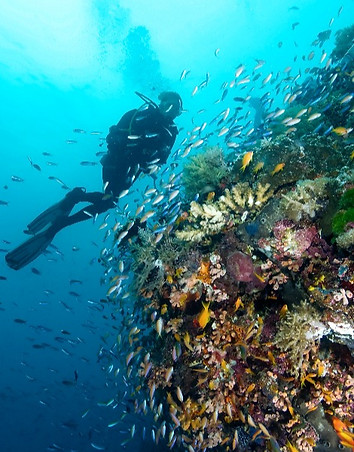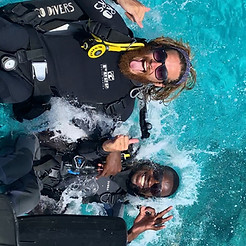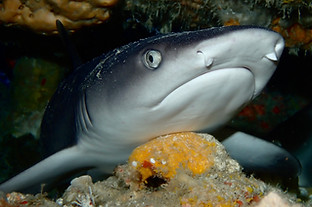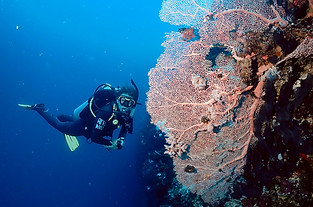


Considered one of the last unspoiled paradises in the Indian Ocean, Pemba is intended for divers seeking a more authentic experience than that offered by the classic destinations of Zanzibar, the Maldives or Egypt.
Unlike most popular diving destinations, Pemba has remained untouched by tourism: the reefs are pristine and nature reigns supreme.
Traveling to Pemba means venturing off the beaten track to a destination far removed from the modern world and the excesses of mass tourism. Pemba has remained under the radar all this time. You won't see any other tourist boats on the horizon, which makes diving expeditions all the more exciting!
Welcome to our dive center, where we pride ourselves on creating an intimate and friendly atmosphere for all our divers. With a focus on personal connections, we ensure each dive is a memorable experience. Our skilled divemasters lead small groups, maintaining a ratio of four divers to one guide, so you receive the attention you deserve. Join us and discover why our divers leave thrilled and satisfied!
Pemba is widely recognised as offering one of the best diving experiences in East Africa.
The dives are magnificent and pristine, with more than twenty different sites (and most of these remain undiscovered!). The corals are very healthy and untouched, creating a colourful paradise!
Tropical coral reef systems, steep walls and tidal currents bring a vibrant reef and pelagic fish to life, making Pemba a top dive destination. It is an excellent option for both beginners and experienced divers. And also snorkelers !
The Pemba reefs are healthy and full of life ! You will find all the varieties of reef fish common to the Indian Ocean.
The underwater topography of Pemba is fascinating: gigantic drop-offs (over 60 metres!), underwater islands, hilly reefs, coral gardens, caves...
Welcome to Afro Divers, where we pride ourselves on being an intimate and professional diving center. Our friendly team is to establishing personal and exclusive relationships with each of our divers. With a skilled divemaster leading every dive and a maximum ratio four divers to one guide, we ensure a safe and unforgettable underwater. Join us and explore the beauty of the ocean in a welcoming atmosphere!

Fun drift diving

WORLDWIDE
Why diving in Pemba ?

Pristine &
healthy reefs

WORLDWIDE


Surface interval
on a beach
Why diving in Pemba island ?

Carlotta
Trip maker
Cat rescuer
Detail lover

Michael
Long time PADI Instructor
Boat entertainer
Story teller

Shafii
Kindest PADI Divemaster
Best smile
Octopus wisperer
Our daily schedule
Breakfast from 7am.
08:15 Meeting at the dive center, we will take care of the documentation, wetsuits on, boots on followed by a 10 minute dive briefing.
09:30 to 10:30 First morning dive.
10:30 to 11:30 Surface interval. We always do more than 60 min of surface interval time for safety reasons. We are going on a different beach every day. There will be water, tea, coffee, pancakes and fruits!
11:30 to 12:30 Second morning dive.
13:00 Lunch time at our restaurant.
For the fanatic divers, there will be an afternoon dive ready.
14:30 Single Afternoon Dive
18:00 Night dive or sunset drinks !




Macro

in

abundance
Dive Sites of Pemba
With our 2 fast boats, we are able to visit the 25 dives site of Pemba North-West coast in a short time!
Experience the breathtaking underwater world of Pemba like never before. Our small group dives ensure that’ll be the sole explorer of this stunning marine paradise. With high-performance gear, a fast diving boat, and an experienced crew we prioritize your safety while delivering an unforgettable adventure. Join us for an exclusive diving experience that you won't forget!
All the dive site can be adapted for each different diving level, from beginners to advanced divers.
Explore the stunning underwater world of Pemba, where 90% remains unexplored!
Every year, we uncover new dive sites that promise breathtaking experiences and unforgettable adventures.
Join us as we dive into the mysteries of this remarkable destination!
Reefs & Corals
Walls
Visibility
Big Fish
Currents
Snorkeling
Wrecks & Caves
Fun
INFOS



Seasons
Our season starts in June after the rain fall. From there the temperature gradually goes up until the next raining period.
Healthy
Coral
Reefs
June: occasional rains and winds, cooler nights, low touristic period. A good period for experienced divers.
July: This is the windiest month of the year. Thankfully we are better protected on the West Coast. Even though we experience many waves the underwater conditions are still good.
August: The ocean gets a lot calmer but also colder. This is probably the coldest month to dive with the water temperature as low as 23 degrees Celsius. Don't worry, we have enough neoprene to keep you warm.
September: September looks a lot like August but with no tourists which makes September a great month to visit. This is the middle of the Humpback Whale Season.
October and November: These months are getting warmer and the ocean is packed with fish. There is the small raining season which seems bad but actually the underwater conditions are excellent during the rains and often big pelagics are spotted.
December: December is one of the best months to visit, especially before the Christmas holidays. Above- as well as underwater we get excellent conditions.
January and February: This is considered the high season due to the fact many Europeans try to flee from the cold. The weather is great and waters are warms, however there are occasional strong North winds that can cause a bumpy ride.
March: March is our favorite month as the ocean becomes wind still and we can practically dive wherever we want. Also there are few tourists so you should definetly have look to come in this period. Officially the raining season starts on the 22nd of March however there is a big chance of good weather even after this date.
April: April is the low season but often the weather is beautiful in between occasional rains. At the end of the month we close our doors and resume in June.
May: We are closed due to the heavy rainfalls. You will find days when it doesn't rain but it is too unpredictable.


Humpback Whales can be spotted from the end of July until the end of October. When you are lucky you will be able to spot them from nearby, see multiple whales in one herd and even see calves such as the one seen on our video.
Dolphins live around Pemba the whole year and they can be spotted in big numbers. We have almost only spinner dolphins, who are very athletic.



Young &
dynamic team


Small diving groups

Dramatic drops off

WORLDWIDE

Endless dive sites

WORLDWIDE

Macro Paradise

WORLDWIDE


Discover the breathtaking beauty of Pemba, a large island celebrated for its stunning coral reefs. At Afro Divers, located in the North West of Pemba, we specialize in unforgettable diving trips that explore the renowned dive sites from the North West to the South West. Experience why Pemba's underwater wonders are recognized worldwide and dive into an adventure like no other. Join us and explore the vibrant marine life that awaits beneath the waves!
Tropical coral reef systems, steep walls and tidal currents that bring in the pelagic fish make Pemba a top dive destination. Though often mentioned Pemba has been kept under the radar all this time.
The diving in Pemba is exciting thanks to its deep and crystal clear water, like the Pemba Channel.
The tidal difference is more than four meters this is creating a lot of currents, especially between the small islands surrounding Pemba, that create small channels. These channels we call gaps.
The many mangrove forests on Pemba contribute to a biodiverse and healthy ecosystem the reefs depend on.
Most of our dive sites are walls that drop off from an average of twelve meters down to fifty meters average and some of them going much deeper.
Drifting along the spacious dive sites should be a good reason to come to Pemba, especially when you have abundance of reef fish and the unpredictable oversized fish passing by.



Many people know Pemba from its deep walls dives, strong and sometimes vertical currents. This is certainly true. Some dive sites must be done with experience and some discipline. However there are always options to find dive sites with more shelter, beautiful coral gardens, that are also not to miss dive sites!



Reef sharks and whale sharks can be spotted on occasion but not regularly. Shark dives are often remote and deep, so the conditions and the skill level of the divers must be taken in consideration.
Many dive sites have cleaning stations, which are characterized by a high biodiversity of shrimps, moral eels and many other critters.



Experience the ultimate relaxation during our surface intervals as we explore a isolated beach each day. Recharge your energy for the next dive while enjoying delicious snacks and refreshing drinks, including tea or coffee. Embrace the beauty of nature and unwind on the pristine shores, creating unforgettable memories between dives. Join us for a perfect blend of adventure and tranquility!












